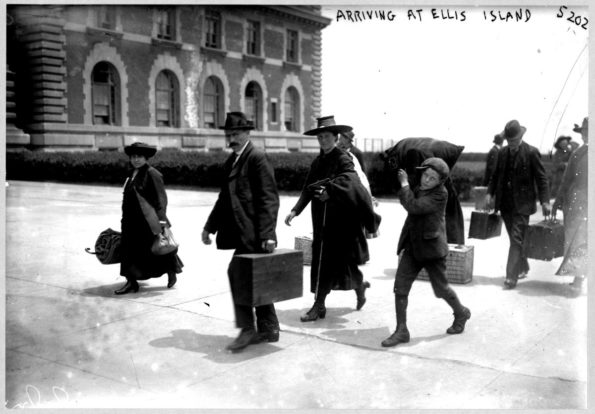Stephen Miller, President Trump’s thirty-one-year-old Senior White House Policy Advisor (yes, you read that correctly)[1] explained the administration’s immigration philosophy succinctly:
“We shouldn’t admit anyone who doesn’t have love in their hearts for this nation and its constitution.”
A friend of mine responded as follows:

“That would have been surprising news to the millions of people who immigrated here last century out of necessity, including my Irish grandparents, only to fall in love with this country later as a result of their experience here.
The same goes for Jews escaping anti- Semitism, Italians escaping fascism, Poles fleeing annihilation, and Eastern Europeans escaping ethnic cleansing, just to name a few.
I’m not sure how much knowledge of the Constitution they had, but surely, they were filled with a mixture of fear, uncertainty and hope for a better life. What they discovered was the incredible promise of America. And baseball! Their love of America, which they imbued on their progeny, came from their experience in America, not from a pre-ordained requirement to love a society about which they knew very little. In fact, they were initially rejected by many incumbent Americans whose only response to immigration was fear; an archetype that seems to never get old!
A great society can be both vigilant and welcoming. Mr. Miller’s ilk should understand that love of country is a reciprocal process.”

In social psychology, reciprocity means that people should repay, in kind, what another person has provided for them. The principle of reciprocity[2] is that people will repay favors, gifts, opportunities, etc. in the future. The sense of future obligation associated with reciprocity makes it possible to build continuing relationships and exchanges.


Reciprocal actions differ from altruistic actions in that reciprocal actions only follow from others’ initial actions, while altruism is the act of giving without any expectation of future positive responses.
I’m wondering if we have been messing up the principle of reciprocity in our immigration policy…or lack thereof. It seems to me that we should be going out of our way to provide opportunities to folks from countries around the world with the expectation that they will return that favor over time – which is exactly what has happened with every immigrant group that has entered this country. Their children and grandchildren have added tremendously not only to our economy but also to our perspective.
One of my most valued mentors, Bill Anthony, suggested over 40 years ago that people listen and respond to those who listen and respond to them. He called this the principle of reciprocity. I believe my kids still listen to me because I spent a lot of time listening to them. As a result, I have been a lucky beneficiary of their love and support. Reciprocity can be a beautiful thing.
In my experience, reciprocity depends on the stronger party taking the initiative to reach out to the weaker or victimized party with positive expectations for a productive relationship. Apparently, Stephen Miller’s philosophy is that the weaker party should take the initiative to build a productive relationship with no expectations of reciprocity.
My hunch is that Miller, who grew up in Santa Monica, California and went to Duke before working for Michele Bachmann and Jeff Sessions, has never had the experience of being a vulnerable victim.
It seems to me that our current immigration policies start from a position of rejection, exclusion and hate. It’s no wonder our way of life is being rejected and has become an object of hate for millions of people around the world.
Perhaps we should think about starting from an attitude of love, acceptance, and inclusion. We may find reciprocal attitudes from Mexicans, Muslims etc. just as we have from the Irish, Italians, Jews, Poles, Hungarians, etc.
What if our immigration policy shifted from:
“We shouldn’t admit anyone who doesn’t have love in their hearts for this nation and its constitution.”
To:
“We should vigilantly accept people from all nations with love in our hearts and with the expectation that they will give back over time much more than we give to them.”
First, let’s dispel some of the biggest myths about immigration. This information is a condensed and adapted version of “Ten Myths About Immigration,”[3] part of the Teaching Tolerance project by the Southern Poverty Law Center.
Myth 1: Most immigrants are here illegally.
Of the more than 41 million foreign-born people living in the United States about 30 million are naturalized citizens, permanent residents and legal residents. Eleven million are unauthorized immigrants. Of those who did not have authorization to be here, about 40 percent entered the country legally and then let their visas expire.

Myth 2: It’s just as easy to enter the country legally today as it was when my ancestors arrived.
In the past, the biggest obstacle would-be immigrants faced was getting here—some even resorted to selling themselves into indentured servitude to do so. Today, there are many rules about who may enter the country and stay legally. Under current policy, many immigrants who arrived between 1790 and 1924 would not be allowed in today.
Myth 3: There’s a way to enter the country legally for anyone who wants to get in line.
The simple truth is that there is no “line” for most very poor people with few skills to stand in and gain permanent U.S. residency. Generally, gaining permission to live and work in the United States is limited to people who are (1) highly trained in a skill that is in short supply here and offered a job by a U.S. employer, (2) escaping political persecution, (3) joining close family already here, or (4) winners of the green-card lottery.
Myth 4: My ancestors learned English, but today’s immigrants refuse.
While today’s immigrants may speak their first language at home, one-half of those older than 5 speak English “very well” according to research by the independent, nonpartisan Migration Policy Institute. And the demand for adult ESL instruction in the United States far outstrips available classes.
Myth 5: Immigrants take good jobs from Americans.
To fill the void of low-skilled American workers, employers often hire immigrant workers. On an economic level, Americans benefit from relatively low prices on food and other goods produced by undocumented immigrant labor.

Myth 6: Undocumented immigrants bring crime.
Nationally, from 1990 to 2010, the violent crime rate declined almost 45 percent and the property crime rate fell 42 percent, even as the number of undocumented immigrants more than tripled. Truth is, foreign-born people in America—whether they are naturalized citizens, permanent residents or undocumented—commit felonies at a much lower rate (3% vs. 8%) than native-born Americans, according to the National Institute of Corrections.
Myth 7: Undocumented immigrants don’t pay taxes but still get benefits.
Undocumented immigrants pay taxes every time they buy gas, clothes or new appliances. They also contribute to property taxes—a main source of school funding—when they buy or rent a house, or rent an apartment. The U.S. Social Security Administration estimated that in 2013 undocumented immigrants—and their employers—paid $13 billion in payroll taxes alone for benefits they will never get. They can receive schooling and emergency medical care, but not welfare or food stamps.
Myth 8: The United States is being overrun by immigrants like never before.
As a percentage of the U.S. population, the historic high actually came in 1890, when the foreign-born constituted nearly 15 percent of the population. By 2012, about 13 percent of the population was foreign-born. Many people also accuse immigrants of having “anchor babies”—children who allow the whole family to stay. According to the U.S. Constitution, a child born on U.S. soil is automatically an American citizen. That is true. But immigration judges will not keep immigrant parents in the United States just because their children are U.S. citizens. In 2013, the federal government deported about 72, 410 foreign-born parents whose children had been born here. These children must wait until they are 21 before they can petition to allow their parents to join them in the United States. That process is long and difficult. In reality, there is no such thing as an “anchor baby.”
The reason I chose to use up so much space to dispel these ugly myths is because I feel they are the primary obstacles to shifting our immigration policy to one that is based on the principle of positive reciprocity, i.e. “we will give you this opportunity and we expect you, over time, to return the favor.”
In my experience, such a shift can only occur when leaders acknowledge the negatives, provide a balanced perspective, and create an inspiring vision.
Acknowledging the negatives means truthfully pointing out the facts. Providing a balanced perspective means showing respectfully that there are usually two sides to an issue. Creating an inspiring vision means mobilizing people behind the values on which we were founded.
![TItle: Julia set of quadratic polynomial with Siegel disk for rotation number [3,2,1000,1...] | Author: Adam Majewski | Source: Wikipedia | License: CC BY 3.0](https://rickbellingham.com/wp-content/uploads/2017/03/Siegel_quadratic_3210001..._-595x595.png)
![TItle: Julia set of quadratic polynomial with Siegel disk for rotation number [3,2,1000,1...] | Author: Adam Majewski | Source: Wikipedia | License: CC BY 3.0](https://rickbellingham.com/wp-content/uploads/2017/03/Siegel_quadratic_3210001..._IIM-595x595.png)
I’m hoping my friend’s response to Miller resonated with you. I’m hoping that you will arm yourself with the facts that dispel the myths circulating around immigration. And I’m hoping you will help others make the shift in their hearts to a more inclusive, loving, generous and accepting space. Take the initiative and expect positive returns.
In spite of our inclination to blame Trump, Bannon, or Miller for these and other problems, the truth is that those individuals only represent the symptoms of a sick system.
The American culture needs to shift from a punishing, mean-spirited, and controlling culture to an informed, compassionate, and empowering culture.
If we don’t make that shift, we will continue to see people like Trump and Miller in positions of power. Let’s create a culture of positive reciprocity instead and elect leaders with open hearts and open minds.
If you liked this post or any of the other articles on this blog, please share it on your Facebook page. I need your help to build a community of people who want to engage in meaningful conversations about substantive issues.
Further Reading:
- [1] “How Stephen Miller’s Rise Explains the Trump White House,” Rosie Gray, The Atlantic, Feb 4 2017
- [2] “The Power of Reciprocity,” Andreas Diekmann, Swiss Federal Institute of Technology
- [3] “Ten Myths About Immigration,” Teaching Tolerance by the Southern Poverty Law Center
Also published on Medium.



Well done Ricky (as always)! Obama, I believe, made those points. I just don’t understand how almost 40% of our countrymen, and apparently the majority of the republican congress, don’t understand. I vow to spread your gospel to all who will listen-which are few on Marco Island-a major reason we’re leaving here as soon as our condo sells! Love you my man! RonnyDonny
Thanks. I’m afraid we have more than an individual problem to solve; we have a larger cultural problem that produced our individual problem. That will be harder to solve.